
Volunteer Movement Gains Momentum
Interest in volunteer activities has recently been increasing in Japan. Many people are involved in volunteer activities, finding through them not only a way to contribute to society, but many personal rewards as well.
Familiarity with the word “volunteer” spread in Japan in the 1970s and the 1980s. During the 1970s, with the proliferation of electric household appliances that helped decrease the labor of housework, people began to have more leisure time, and interest in contributing to society increased. Recognizing the value of volunteer work, the government began issuing subsidies to volunteer centers through the social welfare councils of local municipalities. In the 1980s, Japan participated in UN volunteer programs for the first time, and interest rose in international volunteer work.
In the 1990s, corporations began to engage in programs contributing to betterment of society. Some began to give employees days off to do volunteer work and Nippon Keidanren, the country’s major economic federation, launched the “1 Percent Club,” its members agreeing to set aside 1 percent of their profits for social services. And in 1991, the postal ministry started the “International Volunteer Savings” program, under which a proportion of interest earned was donated to international volunteer activities (discontinued in 2007).
New Era of Volunteering
Amid this heightened awareness of the ways volunteer work contributes to society, the 1995 Great Hanshin-Awaji Earthquake struck Japan, resulting in over 50,000 dead or injured. Volunteers poured into the disaster area from all over Japan, an estimated 1.4 million during the thirteen months following the devastating tremors. Most were young people offering to help for the first time. They served meals, organized and distributed relief goods, collected and transported trash, helped at evacuation sites, provided information to disaster victims, and gave many other forms of support, attracting much attention. Dubbed “Year 1 of the Volunteer Era” from the recognition volunteer activities won and the heightened interest they enjoyed thereafter, 1995 became a watershed. From that time on, when a volcanic eruption, earthquake, flooding from a typhoon, or other natural disaster struck, volunteers would quickly gather at the site, and their work has become an essential part of relief activities.
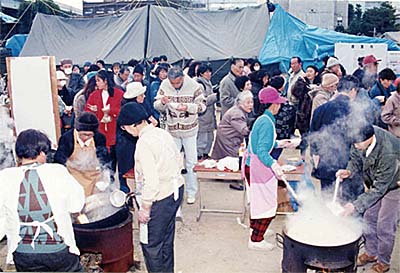
Volunteers cooked and served food for survivors of the Great Hanshin-Awaji Earthquake in January 1995.
© Disaster Reduction and Human Renovation Institution
|
Volunteers moving out relief goods for victims at a disaster site. -> |
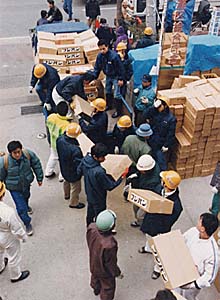
|
Increasing Volunteers
The number of volunteers has increased, not only to help out in the case of disasters, but for routine daily activities. According to the Japan National Council of Social Welfare, the number of people involved in volunteer work as of 2005 is estimated to be about 7.4 million (5.8 percent of total population), some 4.6 times more than the figure for 1980, 25 years ago. The estimated number of people who take part in volunteer activities varies from one study to another and depending on how volunteer activities are defined. Another report (2001 Basic Research on Social Life, compiled by the Ministry of Internal Affairs and Communications) says 28.9 percent of the population have taken part in volunteer activities in the past year.
With the aging of the population and the lower birth rate, aggravation of environmental problems, depopulation and weakening of local communities, and the increase in the number of long-term foreign residents, Japan’s social environment has changed greatly, creating new and diverse needs that the government cannot handle alone. The roles volunteers can play, and the expectations placed in them have greatly increased.
The Russian tanker Nakhodka oil spill Clean-up
In 1997, the Russian tanker Nakhodka spilled heavy oil over a wide area in the Sea of Japan, threatening the ecology of the sea and the coastal fishing industry. In the dead of winter, volunteers gathered from all over Japan to help local citizens remove the oil with scoops and buckets. Through the efforts of 300,000 volunteers, pollution of the sea that might have taken five years to go away was cleaned up in four months.
At the time of the Great Hanshin-Awaji Earthquake in 1995, volunteers had flooded in to help, but coordination of their efforts was poor. Drawing from that experience, it became standard practice to set up a coordinating center immediately after a disaster in order to manage incoming volunteers. The Nakhodka oil spill clean-up effort successfully put to use the lessons learned in the Hanshin-Awaji earthquake rescue effort.
What is Volunteering?
Volunteer work is a somewhat ambiguous term, as its practice differs from one country to another and from one era to another, but generally, it means “service, without compensation, offered of one’s own free will for other people and for society.”
From the distant past, Japan has had customs of mutual aid through which members of village communities would gather to help each other with agricultural and other tasks. Even in modern Japan, local communities have neighborhood associations that organize events such as festivals and town clean-up days. Such activities are volunteer work in a sense, but they are basically communal duties since the participants are doing them as members of their community, rather than voluntarily of their own accord.
In Japan, the Japanese word hoshi, meaning “service,” is sometimes used as an alternative for the English “volunteer,” but the Japanese word implies serving one’s country or society or one’s seniors, sometimes not necessarily of one’s own free will. For this reason, the English loan word, ”volunteer,” is used most of the time.
Volunteer Activities in Schools
With increasing interest in volunteer activities, schools began to make attempts to include them as part of school activities, and from 1998, the national guidelines for the curriculum of schools began to recommend volunteer activities. The entrance screening process of some high schools and universities count the amount of time given to volunteer activities as part of the criteria for evaluation. This practice has been criticized, however, for encouraging students to get involved in volunteer activities not out of good will but as a way of increasing their chances of gaining entrance to a school. Such motives might undermine the real purpose of volunteer activities.
What Kind of Activities are Common?
According to the Japan National Council of Social Welfare, there were 124,000 volunteer organizations as of 2005 in Japan. These organizations engage in a variety of activities, but the most common are for “health, medicare, and welfare,” followed by “community development,” “healthy growth of children,” and “adult education.” Others include “promotion of culture, arts, and sports,” “conservation/environmental protection,” “peace and human rights,” and “international cooperation.”
Volunteers in the category of “health, medicare, and welfare” have been operating for a long time; medical-care volunteer organizations have been offering services since the early 1960s, and their numbers have grown steadily ever since. Their activities include information services in hospitals and other medical institutions and transportation of wheelchair patients. Since the 1980s, when awareness spread of the rapid aging of the population, supports for the elderly have also become more widespread, including nursing care for the elderly and persons with disabilities, organization of social events, and preparation and delivery of meals.
Other volunteer activities include programs for improving communities, support for nature-appreciation activities for children, patrol of communities while children are walking to and from school, beautification projects such as building flower beds and street clean-up, sending relief goods overseas and other international assistance, supporting the management of large-scale events like international movie festivals, and providing tour-guide service for local sightseeing spots. Teaching of Japanese-language classes for longterm residents of Japan from other countries, a service now provided in various parts of the country, is also supported by local volunteers.
Information on volunteer activities can easily be obtained through volunteer centers and the Internet, making it easier for people today to take part in volunteer activities without joining an organization.
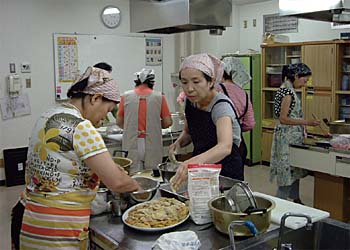
<- Local volunteers make bento suppers for elderly members of the community.
|
Chinese and Japanese volunteers teach Japanese to a junior high school student from China. -> |
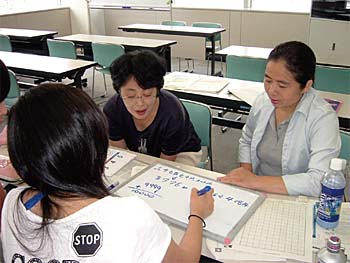
|
What Kind of People Volunteer?
|
Volunteer activists tend to be people who have free time on weekdays; 38.1 percent of volunteers are housewives and 24.5 percent are retirees (“Report of Survey on Japan’s Volunteer Activities,” Japan National Council of Social Welfare, 2001). The number of volunteers is lowest among the late-teens and early 20s age groups. The bulk of daily volunteer activities, therefore, is supported by housewives and retirees. |
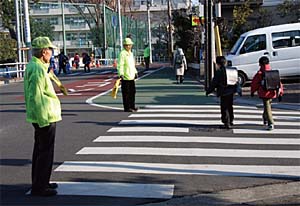 © Uenohara Machizukuri no Kai |
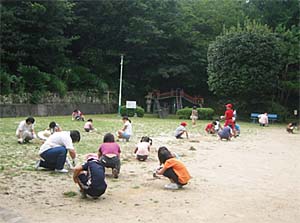 © Tsukahara Akiko |
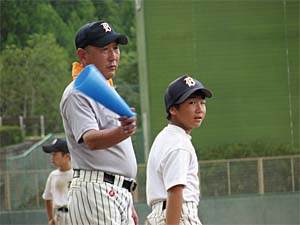 © Chikui Hideto |
The Positive Aspects of Volunteering
Many people who volunteer find they gain great gratification and reward from their activities. Some of the reasons for volunteering include “to do something in return for what the community has done for me” (40.8 percent) and “to help people in need” (34.5 percent), but participants also say that they were able to find new friends and gain valuable experiences from the activities.
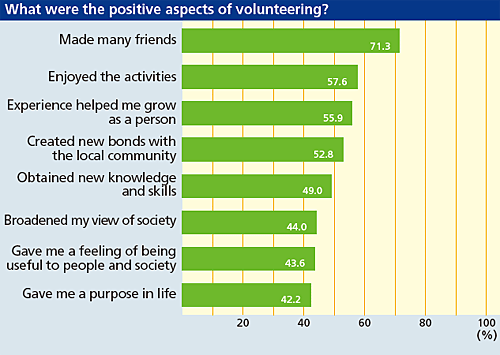
Source: “Report of Survey on Japan’s Volunteer Activists,” Japan National Council of Social Welfare, 2001
Reasons for Not Engaging in Volunteer Work
According to the National Survey on Lifestyle Preferences, 2000, 65 percent of citizens are interested in volunteer activities, but the number of people who actually take part is much smaller. What are the reasons for inability to volunteer despite being interested? The greatest reason is lack of available time; other reasons include having no opportunities and having little access to necessary information.
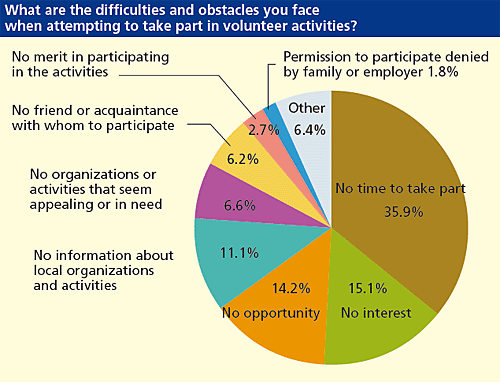
Source: Cabinet Office, “National Survey on Lifestyle Preferences, 2003.”
Volunteer Activities for High School Students
Only 4.6 percent of high school students engage in volunteer activities (“Report on High School Students’ Attitudes Toward Study and Daily Life,” Japan Youth Research Institute). This is largely because they are too busy, but some find time to regularly take part in volunteer activities such as the following:
“Flying Wheelchairs” Project
Students at Prefectural Tochigi Technical High School have organized the “Tochigi Technical High School Global Volunteering Network,” led by the school’s welfare equipmentmaking club and with support from local organizations and non-governmental organizations engaged in social welfare activities. Since 1991 they have repaired used wheelchairs from hospitals and welfare facilities inside and outside Tochigi prefecture for shipment and use overseas. The Network has so far sent 1,785 wheelchairs to 21 nations, including Thailand, the Philippines, Malaysia, Nepal, China, South Korea, India, Sri Lanka, and Kenya. The “Flying Wheelchairs” project has been joined by about 50 other schools throughout Japan.*
The Prefectural Tochigi Technical High School also has a connected project, “International Exchange Volunteer Activity in Thailand.” Every year, about 15 or so students fly to Thailand for eight days to visit the facilities to which the wheelchairs were donated, where they help with further repair of wheelchairs and engage in exchange with the people there. Performing repairs away from home can be difficult, but one student in the project commented as follows:
By the fourth day, we were all pretty tired out. But nobody said a word of complaint. We were all just working hard to fulfill our purpose. When I saw our Thai hosts waving their hands continuously as we left, I was really happy that I was able to take part in this project.
* This story is distributed in the book Sora Tobu Kurumaisu (© Inoue Yuka & Kamoshita Jun, 2008. Published by SOBOKUSHA).
Prefectural Tochigi Technical High School website: http://www.tochigi-edu.ed.jp/tochigikogyo/ (in Japanese only)
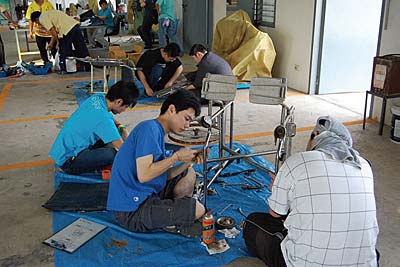
© The Prefectural Tochigi Technical High School
Youth International Volunteer Forum (YouFo)
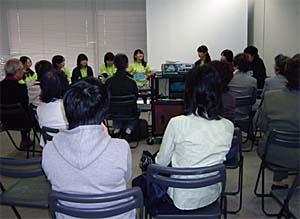
YouFo is an annual event held in Kanagawa prefecture since 2004. At the forum, in addition to charity events and a keynote lecture, high school students present what they have learned about the problems of the world, such as poverty, hunger, medical treatment, and global warming or what they have done as volunteer activities for solving such problems. The aim of the forum is to encourage their peers and others to familiarize themselves with and take part in international volunteer activities.
YouFo is planned and operated by an executive committee organized by local high school students. They nominate nine officers including the chair, vice chair, secretary, and vice secretary, and divide up duties, such as planning and public relations, among themselves. See Meeting People-2.
YouFo website:http://www.xn--s8jte2by2a.jp/index.html (in Japanese only)
Keywords of this issue!
| ボランティア | volunteer |
| ボランティア活動 | volunteer activities |
| ボランティア元年 | Year 1 of the Volunteer Era |
| 保健・医療・福祉 | health, medicare, and welfare |
| 町づくり | community development |
| 国際協力 | international cooperation |
Original text : Takarabako No.17 “Japanese Culture Now” September 2008.
Copyright(C)1997-2008 The Japan Forum. All rights reserved.
Send feedback to forum@tjf.or.jp